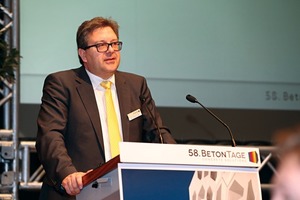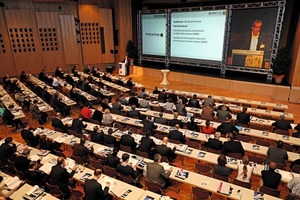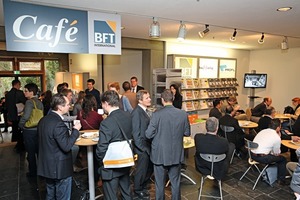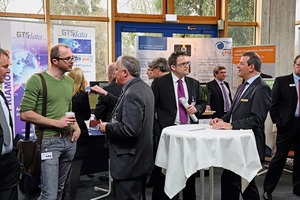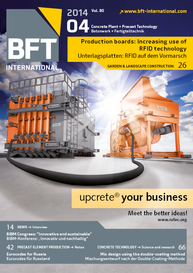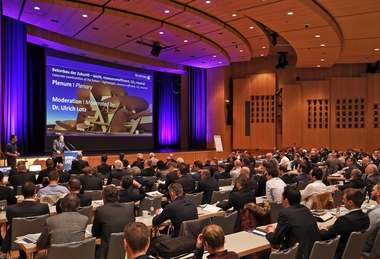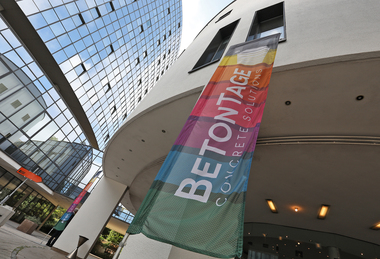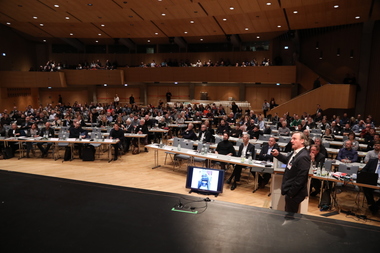Beton Tage: 2,000 participants at the get-together
From 18 to 20 February 2014 it was that time again: the German and international precast concrete industry met at the BetonTage in Neu-Ulm, Germany. About 2,000 participants from 17 nations made use of this platform to broaden their knowledge and to establish and cultivate networks. Accordingly, the congress was able to note a slight increase in attendance and confirm its role as a flagship event of the industry, at its 58th edition. More than 90 interesting presentations and a booked-out exhibition with around 160 representatives of the machinery and engineering, supplier, and software industry awaited the visitors in the EdwinScharff CongressCenter where presentations progressed in the customary bustling and relaxed atmosphere.
The comprehensive technical program was themed “Smart Concretes” and drew its strength from the multitude of topics covered and from the prominent speakers who presented the current requirements from the fields of technology, economy, and law for the concrete industry. The presentations this year had an even more distinctly practical orientation, which was also reflected in the individual product-specific sessions in the afternoon. The agenda once again covered all relevant segments of precast concrete products: e.g., structural precast members, concrete pavers and cast stone, concrete elements with lattice girders, lightweight aggregate concrete, and pipes and manholes. The program was organized in collaboration with relevant technical associations in the industry.
The session headed “Application-oriented research for concrete” centered traditionally on concrete technology. The following session was new: “Power generation and climate protection,” in which the potentials of concrete as building material were emphasized in this context.
From practitioners
for practitioners
Legal questions were discussed in the individual product-specific sessions, with illustration by examples of claims for damages from practice, with related treatment later in the panel “Economy and law.” Leeway in pricing, the current law on annual leave entitlement, and ways to handle contractual penalties were likewise on the agenda.
There was a regular run on the Practice Workshop at the Ferdinand von Steinbeis School in Ulm: so much so that even requests for registration submitted in advance could not be accepted. The training sessions addressed employees and managers in production and has became an established part of the congress. The presentations and hands-on demonstrations obviously attracted great interest – e.g., the sessions on mechanical finishing and compaction of concrete, production of architectural concrete, as well as acid treatment of surfaces.
The panels were also well attended that were specifically conceived for the market partners of the precast concrete industry on the third day of the congress. The organizers and the trade journal DBZ Deutsche Bauzeitschrift and Beton Marketing Süd had extended a joint invitation to the panel “Concrete in Architecture.” Some 300 architects took part here, and gained information on exemplary buildings made of concrete. The speakers included young architects as well as well-known internationally active architectural offices. The BetonTage has a faithful and continuously growing following among structural engineers who this year again made use of the chance for ongoing education. This industrial event has by now also become an established calendar date among building contractors and public authorities.
Benchmark Austria
The guest country, Austria, showed important incentives for the industry as well. Interesting presentations from the fields of research, public relations, technology, and standardization showed how successful exemplary developments for the precast concrete industry can be taken advantage of and implemented. The impulse lectures were integrated in the appropriate plenary and panel events.
This year’s keynote speakers also came from Austria. They offered a look beyond the borders of technology and left a lasting impression on the audience. In his opening speech, Christian Gansch, conductor and successful manufacturer, discussed the analogies between communication and leadership structures of companies and symphony orchestras and provided some pointers for mastering daily job routines.
Focus on communication
Prof. Dr. Markus Hengstschläger, one of the world’s leading geneticists and Ordinarius at Vienna Medical University, turned out to be a brilliant speaker. In his special presentation, the researcher drew amazing parallels between genetics and social and financial developments. To master the challenges and questions of the future, he called for more individuality. His credo was “It must become normal to deviate from the norm.“
BetonTage not only stands for a high-caliber technical program, but likewise serves as an ideal platform for exchange to establish and cultivate contacts. Whether in the coffee breaks, during lunch, in the Media Market, during the evening events, or at the after-work meeting point “FAIRbinden” on the second day of the congress – there were many opportunities for this once again this year and they were once again gladly taken advantage of. Dr. Ulrich Lotz, Managing Director of the organizer of the event FBF Betondienst GmbH, summarized the event with obvious satisfaction: “Our concern is to promote dialogue among each other and industrial partners.” The next BetonTage will take place from 24 to 26 February 2015.

